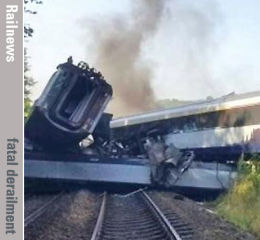Posted 20th April 2021 | No Comments
Questions over drainage at Carmont derailment site

A NEW interim report from the Rail Accident Investigation Branch into the fatal derailment at Carmont near Stonehaven last August has raised question marks over Network Rail’s procedures for inspecting drains on the railway.
Three people were killed on board a ScotRail HST on 12 August when it hit debris. The impact derailed the train and sent it down an embankment. The new report confirms that the train had collided with stones which had been washed on to the track from a gravel-filled crest drain and from ground nearby.
There had been very heavy rain in north east Scotland before the accident, and the RAIB has reported that although there had been repairs to the cutting in 2009, later inspections did not include part of a new crest drainage system which was installed at that time.
In particular, when two Network Rail workers had carried out an inspection in the area on 13 May 2020 they relied on the drain maintenance database, which did not record that part of the drain which was higher up the slope.
However, Network Rail procedures require routine examinations of cuttings such as Carmont. It was last examined on 14 June 2020, when it was classified as hazard category C, on a scale which rises from A to E. The examiner found no serious problems, such as water overflowing, but the RAIB added that examiners are not given any information on drainage arrangements. The examiner did not climb to the top of the cutting and was not required to do so if that would have been unsafe.
A track inspection had been carried out a few hours before the derailment using a road-rail vehicle, and the resulting report had said there were ‘no actionable defects’ at the site.
The drivers’ union ASLEF has welcomed the RAIB’s updated conclusions.
ASLEF’s organiser in Scotland Kevin Lindsay said: ‘It was the landslip – the debris washed on to the track – which caused the train to derail, with the subsequent loss of life, injuries, and catastrophic consequences. We are urging Network Rail to examine every mile of track for which it is responsible, to ensure something like this can never happen again.’
Network Rail has commissioned two external reviews by committees led by independent experts. One deals with Network Rail’s management and understanding of its historic earthworks, while the other considers the implications of climate change.
